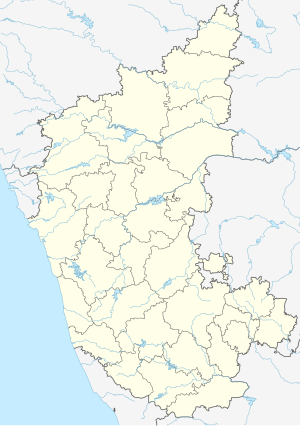Chitradurga Fort
| Chitradurga Fort | |
|---|---|
| Part of Chitradurga | |
| Karnataka, India | |

Ramparts of the fort, Chitradurga, 1868
|
|

Plan of the Chitradurg Fort (1800 AD), also called Kallina Kote / Ukinna Kote / Elu Suttina Kote
|
|
| Coordinates | 14°12′55″N 76°23′43″E / 14.2152°N 76.3953°E |
| Type | Fort |
| Site information | |
| Controlled by | Government of Karnataka |
| Open to the public |
Yes |
| Condition | fine |
| Site history | |
| Built | 18th century |
| Built by | Nayakas of Chitradurga |
| Materials | Granite stones |
| Battles/wars | Nayakas against Hyder Ali in 1760s, 1770s and 1799 |
Chitradurga Fort or as the British called it Chitaldoorg, is a fortification that straddles several hills and a peak overlooking a flat valley in the Chitradurga District, Karnataka, India. The fort's name Chitrakaldurga, which means 'picturesque fort' in Kannada, is the namesake of the town Chitradurga and its administrative district.
The fort was built in stages between the 17th and 18th centuries by the dynastic rulers of the region, including the Rashtrakutas, Chalukyas and Hoysalas as well as the Nayakas of Chitradurga, feudal lords in the Vijayanagar Empire. The Nayakas of Chitradurga, or Palegar Nayakas, were most responsible for the expansion of the fort between the 15th and 18th centuries. They were defeated by Hyder Ali at Chitradurga in 1779. Later the fort was expanded and strengthened by Hyder Ali and his son Tippu Sultan,who succeeded Madakari Nayaka V, the last ruler of the Nayaka clan. The fort is built in a series of seven concentric fortification walls with various passages, a citadel, masjid, warehouses for grains and oil, water reservoirs and ancient temples. There are 18 temples in the upper fort and one huge temple in the lower fort. Among these temples the oldest and most interesting is the Hidimbeshwara temple. The masjid was an addition during Hyder Ali’s rule. The fort's many interconnecting tanks were used to harvest rainwater, and the fort was said to never suffer from a water shortage.
...
Wikipedia

